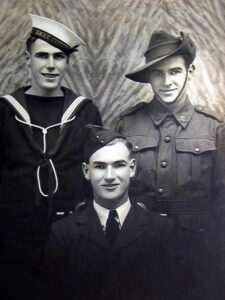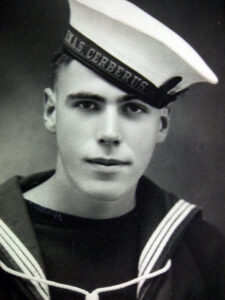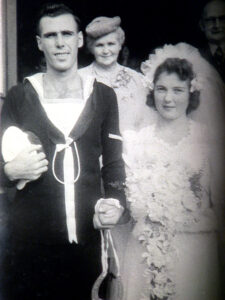I was born in Murrurundi in 1924, where my early years were filled with simple pleasures and family activities. We enjoyed outings like Sunday school picnics, eeling at Pages River, and rabbiting before school. My childhood included adventures with the Church of England Boy’s Society and riding on the railway trolley with my father, who worked on the railways. We also had fun riding on the train’s bumpers, making the most of our local experiences.
In 1935, we moved to Temora, where I completed my schooling amidst the Great Depression. While my family was relatively stable due to my father’s railway job and my mother’s farm, I saw the hardship faced by others, including those in makeshift homes outside town. I helped by delivering potatoes and working odd jobs like selling pies and telegrams to earn extra money. Despite the tough times, we enjoyed activities like biking, football, and swimming.
As I grew older, I decided to join the navy, inspired by stories of World War I from my father, who had served in the Middle East. At 17, the navy was a more accessible option for military service compared to the army or air force. Though my father was likely disappointed, he supported my decision as military service was a family tradition with my brothers and uncle being in the military. Having experienced the coast during holidays, I was drawn to the sea, though I hadn’t yet encountered the open sea in its full extent.

Joining the navy brought its own set of challenges, especially when it came to adapting to the strict regimentation of naval life. The early mornings, physical training in harsh conditions, and constant movement were tough, particularly during training at Flinders, where we faced grueling tasks like swimming fully clothed in freezing water. Many of us, including myself, fell ill with pneumonia and pleurisy. Despite these hardships, the camaraderie among recruits, especially between the more streetwise city boys and us naive country lads, helped us cope.
After training, I was assigned to the ship Wollongong. The first days on board were challenging, with seasickness and tight living quarters making the adjustment difficult. Our journey took us to Melbourne and then to Wollongong, where we experienced lighter moments, like a humorous incident involving the ship getting grounded due to the tide going out. However, these early voyages were relatively uneventful.

The real test came when the Wollongong was deployed to Singapore. Our journey from Australia to Singapore was marked by stops at various ports. As we approached the dangerous waters of the Banka Straits, the sense of peril grew. We encountered enemy planes, which, although initially harmless, later dropped bombs near us, adding to the tension. Despite the dangers, our skilled skipper and the crew’s agility helped us avoid disaster as we finally arrived in Singapore. There, we faced frequent air raids, and the ship’s maneuverability became our best defense against the bombings, showcasing the high stakes of our mission.
Looking back, the Wollongong became a part of me. I learned a lot on that ship—about the sea, about ships, and about myself. I found my sea legs there, and I got to know what it felt like to have control of a ship, even in the toughest conditions. It wasn’t always easy, but it was an experience I wouldn’t trade for anything.
One of the most memorable moments was when we left Singapore and headed down to Tanjung Priok in Jakarta. Navigating the Musi River near Palembang, we had to camouflage our ship with foliage to avoid detection by Japanese patrols. We worked together, cutting down small trees and branches to conceal the ship, making it look like part of the landscape. It wasn’t difficult as we had plenty of tools on board, and we managed to blend in well enough to stay hidden from enemy aircraft.
As we made our way through the Sunda Strait, we conducted patrols and escorted convoys, constantly aware of the lurking dangers. Japanese submarines were a constant threat, making every journey perilous. I remember one close call with the War Sirdar, a ship that had hit an atoll. We tried to tow it off, but a Japanese float plane dropped a bomb nearby, forcing us to cut the towline and eventually scuttle the ship to prevent it from falling into enemy hands. The seas were treacherous, and we narrowly escaped several dangerous situations, including a torpedo that missed us but struck another ship in our convoy, the British Judge.
Despite the challenges, the Wollongong remained a lucky ship. We narrowly escaped many close calls, and the crew stayed close-knit and in good spirits. Our skipper was approachable, and the chief stoker kept everyone in good humor, even when things went wrong. I looked up to the older crew members, who provided a steadying influence during those tough times. The camaraderie and resilience of our crew made the Wollongong a “happy ship,” and we faced every challenge with determination and a sense of humour.
One of the memories that stands out for me is a visit to Chinatown near Keppel Harbour, where I wandered into a Chinese delicatessen. I was eyeing a big side of pork hanging in the shop, but the shopkeeper, a friendly bloke, warned me it might not be to my taste. Instead, he offered to get me a Mahjong set, even though I didn’t know how to play. Intrigued, I agreed to return the next day, but when I did, I found the shop had been hit, and I never got that Mahjong set. It was a close call.
When I returned to the ship, Keppel Harbour was under fire, making it too dangerous to stay anchored there. I recall coming in from patrol only to be signaled that the naval base was under attack, so we had to stay at Keppel Harbour, dodging shells being fired across the Johore Strait. It was a difficult time, but we did what we had to do, always aware of the dangers but never thinking of ourselves as sitting ducks. Even when we were involved in rescues, like the time we saved 300 soldiers from the burning Empress of Asia, we focused on the task at hand, knowing that our survival depended on quick thinking and strong camaraderie.
Towards the end of my naval career, I moved on from Wollongong and joined the Fairmiles, small, fast ships with close-knit crews. However, the Fairmiles weren’t as fast as I had imagined, which was a bit disappointing, but I adapted to my new role, mostly manning the wheel and keeping lookout as we focused on harbour defense and patrol duties.
My journey with the Fairmiles took me to New Guinea, where we provided ASDIC screens to protect against potential threats. Though the conditions were tough, I remained resilient. During this time, I contracted cerebral malaria, leading to a difficult recovery. Reflecting on my experiences, I realise how vulnerable the Fairmiles were and how close we came to making dangerous mistakes, like nearly firing on another Fairmile during a misty patrol. Eventually, I made my way back to Sydney, carrying with me a mix of fondness and pragmatism for all I had learned during my time at sea.
Upon returning home, I quickly transitioned to a new life, marrying Yvonne shortly after and pursuing a career as an electrician with my father-in-law, eventually becoming a contractor. Although my navy service provided security, I didn’t miss it much and focused on building my new life, engaging in activities like tennis and socialising, and avoiding trouble and gambling.

Life in Sydney during the war felt surprisingly normal, with buses, trains, and activities continuing despite occasional blackouts. My relationship with Yvonne was a focus as I looked towards the future, undeterred by the war or the potential threat of a Japanese invasion, which I believed was unlikely due to the support from the Americans.
Looking back on my time in the navy, I see it as a chapter of fulfilling my duty, rather than something that defined who I am. My naval service taught me how to adapt and get the job done, no matter the circumstances. I’ve gained valuable technical skills along the way, and I’d encourage younger generations to consider the benefits of a naval career. For me, the war was about standing by our allies and doing what was necessary, rather than personal beliefs or judgments.
I currently enjoy my retirement at RSL ANZAC Village in Narrabeen, where I moved in May 2013. I stay very active socially, regularly participating in events and various village activities. I especially look forward to the men’s days out. Life here has been wonderful, and I’ve made many new friends along the way.” – Maxwell Frank Marvin.
Maxwell has participated in many RSL LifeCare Anzac and Remembrance Day events, and we truly appreciate Max’s involvement. Below is a video from last year’s Remembrance Day campaign where Maxwell shares memories of his service.
Continue Reading
Discover our Services
Home Care
Retirement Living
Residential Care
Veteran Services
Download a brochure
We'll never share your email address and you can opt out at any time, we promise


